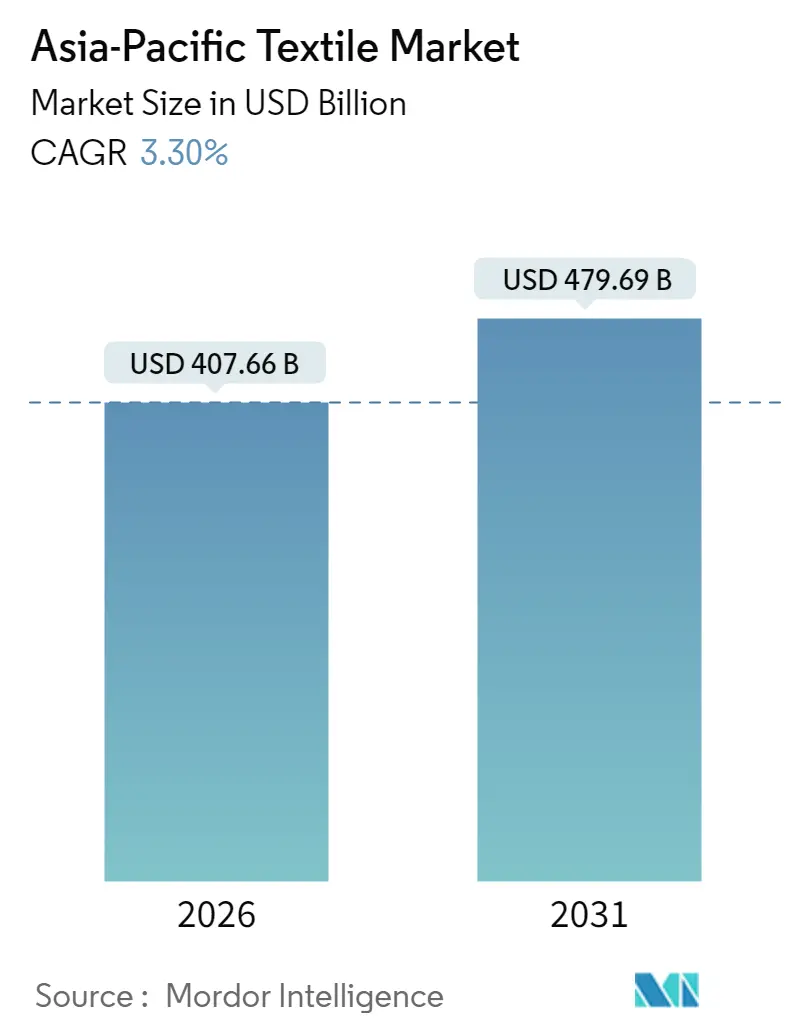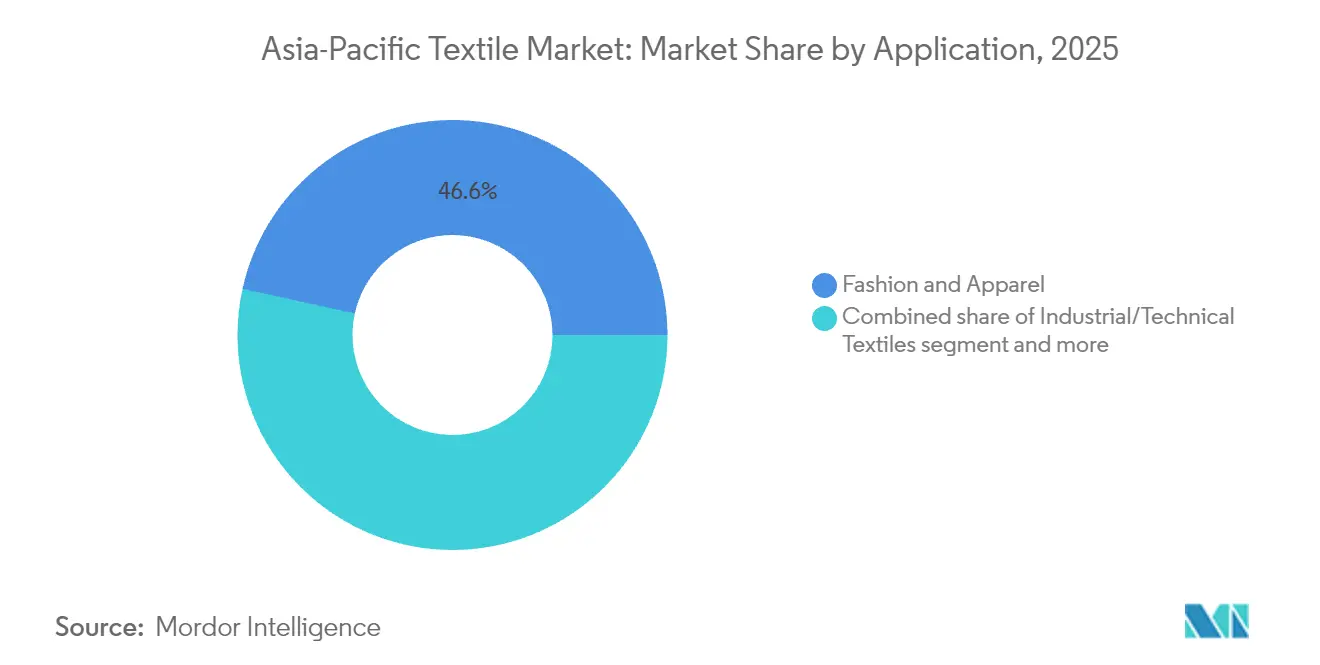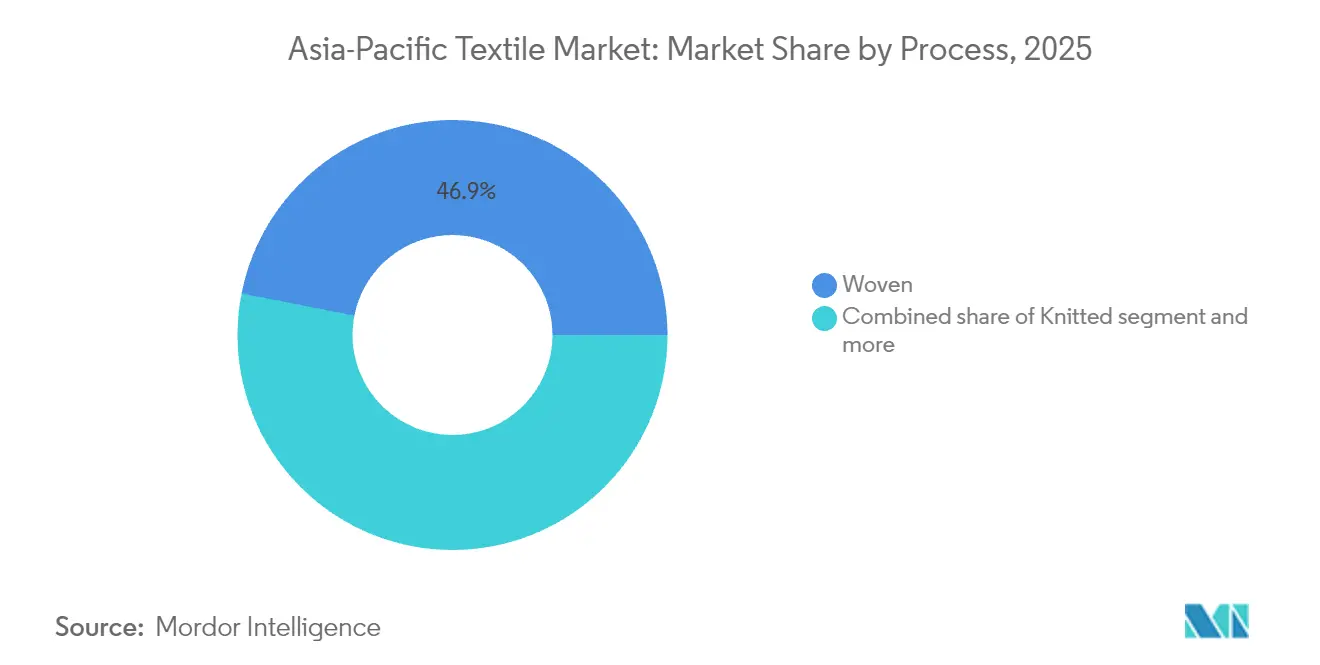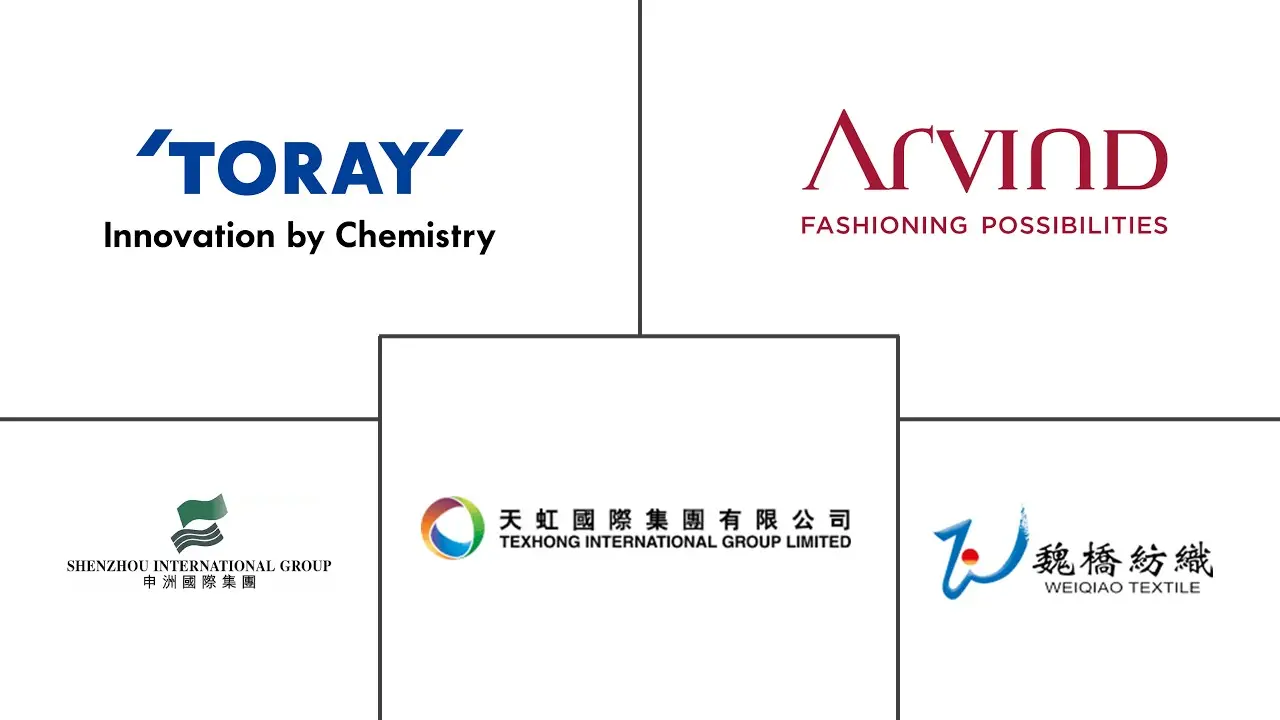
Asia-Pacific Textile Market Analysis by Mordor Intelligence
The APAC Textile Industry Market is expected to grow from USD 394.64 billion in 2025 to USD 407.66 billion in 2026 and is forecast to reach USD 479.69 billion by 2031 at 3.3% CAGR over 2026-2031. This steady headline number masks a widening gap between low-margin bulk products and higher-value technical applications that now attract premium pricing. Cost-sensitive output continues to cluster in traditional hubs, while technology-intensive manufacturing migrates to newer sub-regions equipped with advanced machinery and skilled labor. Rising energy costs, ESG compliance mandates, and automation investments are reshaping competitive advantages, prompting both supply-chain diversification and vertically integrated operations. The APAC textile industry market, therefore, moves toward a dual-track growth pattern in which efficiency gains and product innovation, rather than volume alone, determine profitability.
Key Report Takeaways
- By application, fashion and apparel led with a 46.55% share of the APAC textile industry market in 2025, whereas industrial and technical textiles are projected to expand at a 4.65% CAGR through 2031.
- By raw material, synthetic fibers commanded 48.05% of the APAC textile industry market size in 2025; polyester within this category is on course for a 5.05% CAGR to 2031.
- By process, woven fabrics retained 46.90% of the APAC textile industry market in 2025, yet non-woven technologies are advancing at a 4.55% CAGR through 2031.
- By geography, China accounted for 58.30% of the APAC textile industry market share in 2025, while ASEAN is set to record the fastest regional CAGR of 4.35% to 2031.
Note: Market size and forecast figures in this report are generated using Mordor Intelligence’s proprietary estimation framework, updated with the latest available data and insights as of January 2026.
Asia-Pacific Textile Market Trends and Insights
Drivers Impact Analysis
| Drivers | (~) % Impact on CAGR Forecast | Geographic Relevance | Impact Timeline |
|---|---|---|---|
| Premiumization of apparel spend | +0.8% | Global, with concentration in urban APAC markets | Medium term (2-4 years) |
| Growth of organized fashion retail | +0.6% | India, China, ASEAN core markets | Medium term (2-4 years) |
| Emerging "near-shoring" to ASEAN+India | +0.5% | ASEAN, India, with spillover effects to China | Short term (≤ 2 years) |
| ESG-linked sourcing mandates by global brands | +0.4% | Global impact, strongest in China, Vietnam, Bangladesh | Long term (≥ 4 years) |
| Breakthroughs in bio-based fiber R&D | +0.3% | Global, with early adoption in Japan, South Korea | Long term (≥ 4 years) |
| AI-driven demand-forecasting adoption | +0.2% | Global, led by China, Japan, South Korea | Medium term (2-4 years) |
| Source: Mordor Intelligence | |||
Premiumization of Apparel Spend
Growing disposable incomes in APAC’s metropolitan areas lift demand for luxury and performance garments. Brands respond by investing in traceability platforms and low-impact production, which lets manufacturers capture higher margins through vertical integration. Ermenegildo Zegna, for instance, reported USD 166.1 million in regional textile revenue in 2023, underscoring the insulating effect of premium positioning against raw-material volatility. Technical-textile suppliers benefit most because their performance attributes justify price points that are three to five times above commodity fabrics[1]Gildo Zegna, “FY 2023 Results Presentation,” Ermenegildo Zegna Group, ermenegildozegna.com.
Growth of Organized Fashion Retail
Large retail chains now dominate distribution and insist on strict quality, delivery, and compliance standards. India’s exports reached USD 36.6 billion in FY 2025, in part because certified mills could meet these buyer requirements. As store networks scale, they shift competition away from price and toward service levels, environmental audits, and digital collaboration tools, edging out small, non-compliant factories[2]Shailesh Pathak, “Textile Export Performance FY 2025,” Invest India, investindia.gov.in.
Near-shoring to ASEAN + India
Tariff exposure, pandemic disruption, and shipping bottlenecks speed up investment in Vietnam, Indonesia, and India. Delta Galil committed USD 100 million to a Vietnam plant, whereas Huafu Fashion now operates 60% of its spindle capacity outside China. These migrations position ASEAN for higher-value work, while China pivots toward automation-rich technical textiles. Governments encourage the trend through free-trade agreements and fast-track environmental permitting.
ESG-linked Sourcing Mandates
Global brands add environmental and labor metrics to supplier scorecards, forcing mills to provide multi-tier visibility into cotton, chemical, and energy inputs. Partnerships such as Epson and HKRITA’s cotton-waste regeneration initiative exemplify how collaborative R&D satisfies brand targets while opening new revenue pools. High compliance costs accelerate consolidation toward vertically integrated players with internal testing and reporting capacity[3]Sue Covey, “Due Diligence Guidance for Garment and Footwear 2024,” Organization for Economic Co-operation and Development, oecd.org.
Restraints Impact Analysis
| Restraints | (~) % Impact on CAGR Forecast | Geographic Relevance | Impact Timeline |
|---|---|---|---|
| Energy-price volatility hitting spinning margins | -0.7% | Global, particularly energy-intensive markets like China, India | Short term (≤ 2 years) |
| US-China trade policy uncertainty | -0.5% | China, with spillover to regional supply chains | Short term (≤ 2 years) |
| Stringent wastewater norms for dye-houses | -0.4% | India, China, Bangladesh, Vietnam | Medium term (2-4 years) |
| Loom-level labor shortages in tier-2 clusters | -0.3% | India, Bangladesh, Vietnam tier-2 manufacturing hubs | Medium term (2-4 years) |
| Source: Mordor Intelligence | |||
Energy-Price Volatility
Spinning consumes up to 70% of a mill’s electricity, so sudden rate hikes compress gross margins. While some Indian states offer subsidies, most cover only a fraction of costs, pushing small mills toward closure or merger. Larger groups hedge through long-term power-purchase agreements and on-site solar arrays, dampening the immediate impact but still trimming forecast growth.
Stringent Wastewater Norms
Zero-liquid-discharge requirements in India and fluorochemical bans in Singapore demand costly upgrades in dye-houses. Capital outlays for membrane bioreactors or evaporators can reach 20% of plant value, an amount unaffordable for small processors. Compliance thus favors integrated groups that spread costs across higher volumes.
Segment Analysis
By Application: Technical Textiles Drive Innovation
Industrial and technical categories are on a 4.65% CAGR, lifting their portion of the APAC textile industry market size each year as automotive, medical, and filtration buyers specify higher-performance substrates. In contrast, fashion and apparel’s 46.55% share shows minimal expansion because sustainability headwinds offset fast-fashion volume. Medical non-wovens surged during and after the pandemic, and automotive textiles benefit from electric-vehicle heat-management needs. Household segments hold steady due to urbanization, while protective gear grows alongside occupational-safety legislation. Greater sensor integration blurs lines between apparel and smart-fabric niches, expanding the addressable pool of premium orders.
The near-term outlook sees technical providers capitalizing on regulatory barriers, ISO 13485 in healthcare, and stringent OEM specifications in transport, which discourage new entrants. Existing suppliers invest in automated looms and advanced coatings, reinforcing their grip on value-added niches. Over the forecast period, these moves will widen the profitability gap between technical and commodity segments within the broader APAC textile industry market.

Note: Segment shares of all individual segments available upon report purchase
By Raw Material: Synthetic Dominance Faces Sustainability Pressure
Synthetic inputs hold 48.05% of the APAC textile industry market in 2025, and polyester’s 5.05% CAGR underscores its enduring cost-performance appeal. Far Eastern Group’s recycling partnerships illustrate how circular feedstock loops keep polyester competitive while lowering environmental scores. Natural fibers contend with weather risks and higher traceability costs, limiting their share gains. Specialty high-performance yarns such as aramid and UHMWPE attract premium demand in aerospace, defense, and extreme-sports gear, although supply volumes remain small.
As bio-derived alternatives mature, mills will balance fossil-based inputs with ferment-based chemistries, diversifying risk and satisfying brand targets. Feedstock integration strategies, long-term resin contracts, or captive recycling plants become critical for margin defense, especially when oil-price swings rattle raw-material budgets.
By Process: Non-woven Technologies Accelerate
Woven fabrics still make up 46.90% of the APAC textile industry market share, yet non-woven routes show the strongest growth at 4.55% CAGR. Melt-blown and spun-bond lines flexibly serve filtration, hygiene, and medical markets where end-users prize tensile strength and barrier properties over drape or comfort. Knitting retains a foothold in sportswear but faces labor-cost inflation. Spacer fabrics and 3-D weaving open new possibilities in footwear and automotive interiors, attracting capital-expenditure commitments from technology-focused mills.
Process selection now hinges on automation potential and energy intensity. Non-woven installations demand high upfront machinery spend but grant rapid throughput and labor savings, positioning well-capitalized players for long-term share gains.

Note: Segment shares of all individual segments available upon report purchase
Geography Analysis
China holds 58.30% of the APAC textile industry market, anchored by unmatched vertical integration, massive synthetic-fiber capacity, and rapid automation uptake. Even so, exports to the United States fell 9.4% CAGR between 2020 and 2024 as tariffs and compliance scrutiny mounted. Leading firms such as Shenzhou International therefore expanded plants in Vietnam to maintain near-market flexibility. Domestic investment now concentrates on high-tech and recycled fibers backed by large-scale solar arrays that trim energy risk.
ASEAN is the fastest-growing bloc at 4.35% CAGR. Vietnam tops inbound investment, highlighted by Delta Galil’s USD 100 million facility and Huafu Fashion’s spindle clusters. Indonesia struggles with closures at roughly 60 mills from 2022 to 2024 yet remains attractive for man-made fiber due to petrochemical feedstock access. Thailand and Malaysia leverage established petrochemical value chains to supply regional converters, while the Philippines focuses on apparel assembly for Japanese brands.
India rides policy support and demographics to lift exports to USD 36.6 billion in FY 2025. The government earmarked USD 635.2 million for a five-year cotton mission that targets yield gains and traceability. Production-Linked Incentives, upgraded industrial parks, and faster port clearances shorten lead times, positioning India as a preferred “China + 1” sourcing node.
Bangladesh contends with political unrest that temporarily shifts orders to India, whereas Australia plays in wool processing and textile recycling, capitalizing on domestic raw wool and R&D alliances. Japan and South Korea specialize in carbon fiber, aramid, and smart textiles, exporting high-margin niches that reinforce their technology-leader status.
Competitive Landscape
Competitive intensity differs sharply across the value chain. Spinning and weaving remain fragmented, with thousands of sub-scale mills competing on price. By contrast, technical textiles and advanced materials form oligopolies where R&D budgets and patent portfolios set barriers. Leading groups practice vertical integration to capture spinning, dyeing, and garmenting under one roof, insulating margins and controlling quality.
Technology adoption is the current fault line. Firms implementing AI scheduling, digital twins, and robotic handling achieve waste cuts of up to 15%, translating into price flexibility and faster response to retailer orders. Sustainability credentials now function as table stakes: ISO 14001, OEKO-TEX, and traceability ledgers no longer confer premium pricing but remain mandatory for global contracts. Opportunity remains for mid-size specialists in bio-based yarns, enzyme recycling, and e-textiles, where incumbents hold limited share.
Asia-Pacific Textile Industry Leaders
Shenzhou International Group
Weiqiao Textile
Texhong Textile Group
Toray Industries
Arvind Ltd
- *Disclaimer: Major Players sorted in no particular order

Recent Industry Developments
- August 2025: Deakin University and Samsara Eco agreed to build an enzyme-based recycling plant targeting 500 million garments annually by 2030.
- July 2025: Epson and HKRITA produced regenerated cellulose from waste cotton using Dry Fiber Technology under a 2024 R&D pact.
- May 2025: Deakin University, Country Road, Full Circle Fibers, and Loomtex secured USD 0.21 million for the three-year “Mud to Marle” wool-fabric project.
- April 2025: Opal began a uniform-recycling pilot with BlockTexx at its Sydney paper mill, turning old textiles into reusable fibers.
Asia-Pacific Textile Market Report Scope
The textile industry involves sections like research, design, development, manufacturing, and distribution of textiles, fabrics, and clothing. A complete background analysis of the Asia-Pacific Textile Market, including the assessment of the economy and contribution of sectors in the economy, market overview, market size estimation for key segments, and emerging trends in the market segments, market dynamics, and geographical trends, and COVID-19 impact is included in the report.
The Asia-Pacific textile market is segmented by application (clothing, industrial and technical, household, and other applications), by material (cotton, jute, silk, synthetics, and wool), and by geography (China, India, Pakistan, Bangladesh, Australia, and Rest of Asia-Pacific). The report offers market size and forecasts for the Asia-Pacific Textile Market in value (USD) for all the above segments.
| Fashion & Apparel |
| Industrial/Technical Textiles |
| Household & Home Textiles |
| Medical & Healthcare Textiles |
| Automotive & Transport Textiles |
| Others (Protective, Sports Textiles, etc.) |
| Natural Fibers | Cotton |
| Wool | |
| Silk | |
| Synthetic Fibers | Polyester |
| Nylon | |
| Rayon / Viscose | |
| Acrylic | |
| Polypropylene | |
| Recycled Fibers | |
| Others (Speciality High-Performance Fibers (Aramid, Carbon, UHMWPE)) |
| Woven | |
| Knitted | |
| Non-woven | Spunlaid (Spunbond / Melt-blown) |
| Dry-laid Hydro-entangled | |
| Wet-Laid | |
| Needle-punched | |
| 3-D Weaving & Spacer Fabrics |
| China |
| India |
| Bangladesh |
| Australia |
| South Korea |
| Japan |
| ASEAN (Indonesia, Thailand, Philippines, Malaysia, Vietnam) |
| Rest of Asia-Pacific |
| By Application | Fashion & Apparel | |
| Industrial/Technical Textiles | ||
| Household & Home Textiles | ||
| Medical & Healthcare Textiles | ||
| Automotive & Transport Textiles | ||
| Others (Protective, Sports Textiles, etc.) | ||
| By Raw Material | Natural Fibers | Cotton |
| Wool | ||
| Silk | ||
| Synthetic Fibers | Polyester | |
| Nylon | ||
| Rayon / Viscose | ||
| Acrylic | ||
| Polypropylene | ||
| Recycled Fibers | ||
| Others (Speciality High-Performance Fibers (Aramid, Carbon, UHMWPE)) | ||
| By Process / Technology | Woven | |
| Knitted | ||
| Non-woven | Spunlaid (Spunbond / Melt-blown) | |
| Dry-laid Hydro-entangled | ||
| Wet-Laid | ||
| Needle-punched | ||
| 3-D Weaving & Spacer Fabrics | ||
| By Geography | China | |
| India | ||
| Bangladesh | ||
| Australia | ||
| South Korea | ||
| Japan | ||
| ASEAN (Indonesia, Thailand, Philippines, Malaysia, Vietnam) | ||
| Rest of Asia-Pacific | ||
Key Questions Answered in the Report
What is the projected value of the APAC textile industry market in 2031?
It is expected to reach USD 479.69 billion, reflecting a 3.30% CAGR from 2026.
Which region is forecast to grow fastest within APAC’s textile sector?
ASEAN is set to record a 4.35% CAGR through 2031, benefiting from near-shoring and policy incentives.
Which application segment is expanding most quickly?
Industrial and technical textiles are advancing at a 4.65% CAGR, outpacing fashion and apparel.
How large is China’s share in the APAC textile industry market?
China commanded 58.30% of regional revenue in 2025, although its share is gradually easing as production diversifies.



